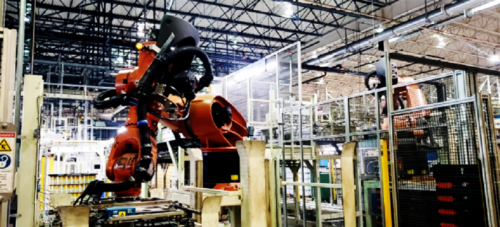Moving toward manufacturing sustainability
We are nearing the tipping point where global awareness of the climate problem finally shifts to global action. To avoid severe environmental and human consequences, society must limit the increase in global mean surface temperature while conserving available resources. This will require a shift to a climate-driven, resource-efficient, low-emissions economy.
We are nearing the tipping point where global awareness of the climate problem finally shifts to global action. To avoid severe environmental and human consequences, society must limit the increase in global mean surface temperature while conserving available resources. This will require a shift to a climate-driven, resource-efficient, low-emissions economy.
Most manufacturers have had environmental responsibility programs and policies of some sort in place for 50 years or more — but the new pressures will demand increased attention to the environment. Manufacturers are already beginning to see significant new constraints, regulations and climate- or resource-based business drivers. These will only escalate.
Significant new technology advances may emerge in the future to support sustainable manufacturing. In the meantime, much progress can be made by taking a fresh look at many existing manufacturing, supply chain, plant engineering and maintenance practices.
Today’s plants have been designed to produce products of a certain type at a certain quality and rate, but the underlying cost assumptions may not reflect emerging requirements. For example, the original design parameters probably didn’t explicitly consider the carbon burden associated with the physical plant. And while energy usage may have been a consideration, many older plants were designed with the assumption that energy costs would remain constant.
Manufacturers need to factor the inherent energy, carbon, waste and water burden associated with the existing physical plant into their sustainability strategies. In some cases, operating improvements may be enough to achieve new targets. In other cases, more efficient production equipment, or even new plants, may be required.
Moving to a sustainable manufacturing model may require significant changes throughout the enterprise, touching business strategy and planning, manufacturing operations, design and engineering, supply chain management and facilities management.
At the plant level, existing process control optimization, energy management, utilities management, reliability-centered maintenance and supply chain management initiatives can serve both as a foundation and a springboard for future sustainable manufacturing improvements.
Abatement opportunities for industry
According to the International Energy Agency, industry currently accounts for about one-third of total global energy use. The sector is responsible for about 22% of worldwide carbon dioxide emissions, of which 26% are from the iron and steel industry, 25% from non-metallic minerals and 18% from petrochemicals.
The IEA identified these potential abatement opportunities for the industrial sector:
In primary steel production, efficiency improvements on the order of 20% to 30% are available based on existing technology
Improvements to steam supply systems and motor systems offer efficiency potentials on the order of 15% to 30%
Combined heat and power generation can bring 10% to 30% fuel savings over separate heat and power generation
Waste recycling reduces energy demand, but is limited by the availability of waste materials
The production of paper from pulp can use close to zero (net) energy, due partly to the ability to co-generate both electricity and steam from liquid and solid biomass residues. Outdated small-scale paper plants in developing countries, notably China and India, could substantially reduce energy needs with larger plants, more efficient drying technologies and black liquor gasification.
The cement and chemicals industries are approaching the theoretical minimum energy use in many countries. However, China could improve the energy efficiency of its cement industry by almost 50%.
Using biomass feedstocks and recycling more plastic waste could substantially reduce lifecycle carbon dioxide emissions
Carbon capture and storage (CCS) could be applied to several industries on a gigaton-scale, especially in the production of chemicals, iron and steel, cement and paper pulp.
In manufacturing industries, production operations account for a large portion of the total energy and water consumed and waste and emissions generated. Some areas of particular interest to plant engineering departments include energy management, water management and waste management, as well as contributing to increased production efficiency.
Energy management
Sustainable energy practices involve improving energy conservation and efficiency, as well as changing to alternative energy sources where possible. In many cases, manufacturers can reduce their energy consumption by using energy as a production metric.
Manufacturers need to employ new approaches to energy management to achieve substantial reductions in energy usage and carbon dioxide emissions.
In Japan, Nissan (using the Mitsubishi Factory Energy Management System) has piloted an active, real-time approach to energy management. The company changed focus from site energy saving to plant floor-based energy saving. This required additional monitoring, but provided the means to proactively control and reduce energy usage, rather than just getting a monthly report.
Nissan also added local air conditioning improvements and provisions for an energy-saving mode for off-duty time and implemented small group initiatives to pursue continuous improvement.
The U.S. Department of Energy’s Energy Efficiency and Renewable Energy Industrial Technologies Program ( www1.eere.energy.gov/industry ) provides sourcebooks, tip sheets, technical fact sheets and handbooks on many of the above subjects.
Another area where engineers in industrial process manufacturing plants in particular can contribute to more efficient energy usage (as well as reduced raw material usage) is to take a good look at the control valves installed on the process. In all too many cases, improperly sized, installed, configured or maintained control valves can result in inefficient process cavitations, flashing and off-specification product, as well as excessive energy consumption.
Waste management
Solid waste generation is a known environmental concern that must also be factored into a manufacturer’s sustainability strategy. Among other requirements, Wal-Mart requires its manufacturing and other suppliers to reduce solid waste generation.
Manufacturers will need to plan, monitor, document and manage solid waste generation, and may need to improve existing hazardous and non-hazardous solid waste handling techniques. Reaching solid waste goals may require issuing packaging guidelines to upstream suppliers and working with them to reduce packaging materials.
Other possible mitigation technologies and practices include landfill methane recovery, waste incineration with energy recovery, composting of organic waste, controlled waste water treatment and recycling and waste minimization.
Production efficiency
Most manufacturers already place a premium on production efficiency, but sustainability requirements will make this even more critical. New scheduling algorithms may take energy usage and carbon dioxide generation explicitly into account. Bottleneck identification and constraint removal will become more important.
New, ultra-efficient manufacturing process designs will have implications for existing production facilities and assets. Advanced process control and optimization techniques can help process manufacturers reduce consumption of both energy and raw materials and reduce emissions.
Information exchange with business and supply chain systems will have a higher priority to eliminate lag time and improve overall business processes.
Energy consumption measurements and metrics will need to be put in place to help reduce energy consumption by using energy as a production metric. In addition to new metering and data collection devices, new software functionality will be required to make the detailed production energy consumption visible and to enable better decision-making and control.
This article was adapted from an ARC Advisory Group strategy report, titled, “Sustainable Manufacturing: Remaking the Manufacturing Enterprise for Tomorrow’s Economy.” For more information, or to obtain a copy of the report, readers can visit www.arcweb.com .
Eight ways to cut energy consumption
Some specific areas where plant engineering departments can contribute to reduced energy consumption, include:
Improving the efficiency of industrial boilers, chillers, heat exchangers, compressors and other plant process equipment
Reducing plant steam consumption
Reducing compressed air consumption and/or optimization of compressed air systems (according to one source, in the U.S. alone, compressed air for industrial purposes accounts for $1.5 billion in energy costs and 0.5% in emissions annually and optimization of compressed air systems can provide 20% to 50% improvement in energy efficiency)
Improving fan system performance
Improving motor and drive system performance (variable speed drives can operate machinery with 20% to 30% more efficiency than fixed speed motors)
Replacing older, inefficient and possibly incorrectly sized electric motors with newer, more efficient and properly sized motors
Implementing smart heat tracing systems that activate only when the temperature falls below a predetermined limit (BASF has realized an 80% energy savings at its Ludwigshafen manufacturing complex through heat trace system improvements.)
Lighting efficiency improvements through the use of smart light fixtures, retrofitting fluorescent lights with high-efficiency adaptors or installing LED and OLED lighting, where appropriate.
Do you have experience and expertise with the topics mentioned in this content? You should consider contributing to our CFE Media editorial team and getting the recognition you and your company deserve. Click here to start this process.





